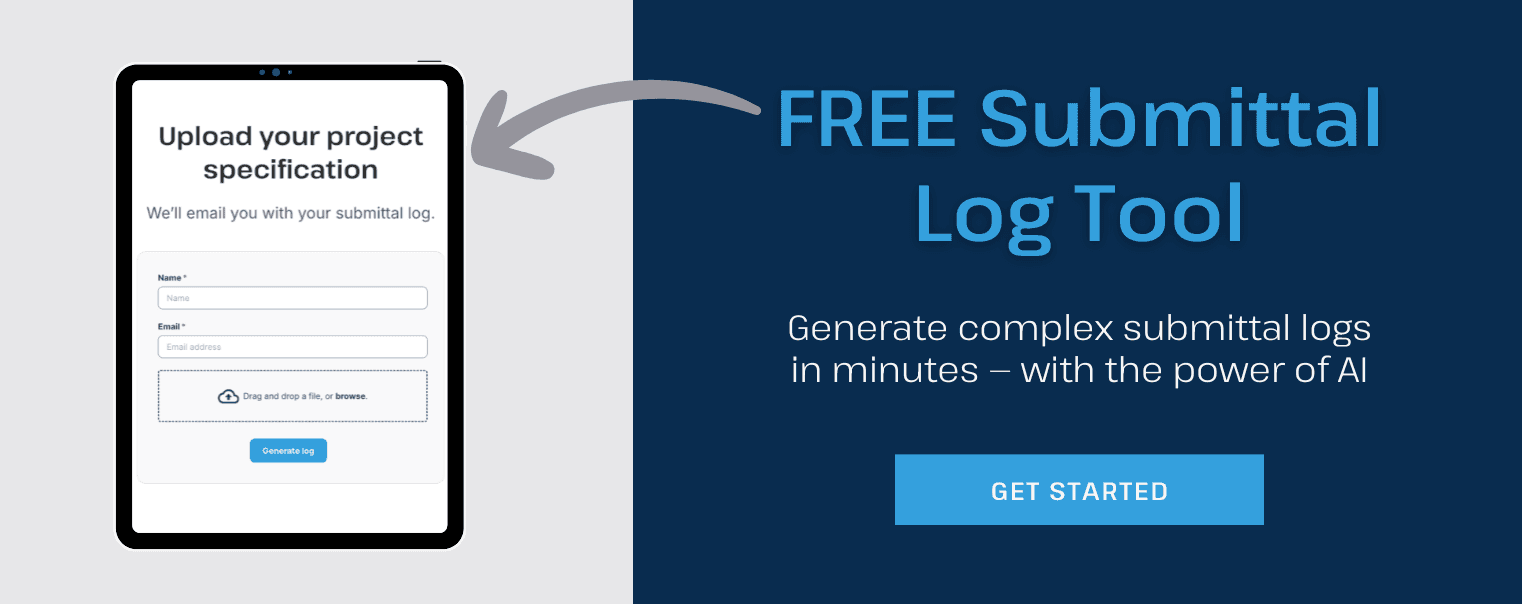Guide
The Complete Guide to Construction Submittals
Learn about the types of submittals, why they’re important, the submittal process, and how to avoid common challenges.
Nov 7, 2023
Submittals play a critical role in the construction process. When managed correctly, they help ensure compliance with regulations and allow all parties involved to track the progress of a construction project.
In this blog, we’ll cover the types of submittals, why they’re important, the submittal process, and how to avoid common challenges.
Definition of Construction Submittals
What are construction submittals?
Before we get too deep, let’s start with the basics: what is the meaning of submittals in construction?
Construction submittals are defined as documents that a contractor provides to the owner’s representative, usually an architect or engineer, for approval. These documents can include shop drawings, product cut sheets, material samples, mockups, vendor details, calculations, test reports, warranties and manuals, as-built drawings, test results, and even meeting notes. Utilities, energy sources, safety measures, proposals, bids, agreements, certificates, change orders, and special installation details can also be included, depending on the construction project.
The architect reviews these submittal documents and confirms that they align with the intended design and project specifications. This part of the submittal process happens before materials and equipment are fabricated and sent to the job site.
Why are construction submittals important?
Submittals are important because they help ensure that projects are executed safely, on time and on budget, and according to designs and specifications. Practically every detail of a project needs to be reviewed and approved via submittal before construction begins. Failing to do so could result in setbacks for the construction project.
In short, submittals help reduce risk, improve the quality of the project, and reduce re-work.
Say, for example, that a contractor installs tile floors in an office tower without first getting a submittal approval. Although the tiles might look almost identical to the ones the architect requested, they are in fact made of a more expensive material. As a result, the project goes over budget and no longer aligns with the intended design.
Reviews and approvals are tracked in a construction submittal log, which acts as a record that the design team has approved each item of consequence. This can be important down the road if approvals are called into question.
Types of Submittals
There are a number of submittal types everyone on a construction project should be aware of. Each of these construction documents could potentially be included in a submittal package.
#1 Shop drawings
Shop drawings are used to illustrate how a contractor will meet the construction project’s design intent, facilitate compliance, and provide essential diagrams, schedules, and other data to be used throughout the project build.
Sometimes referred to as technical drawings or fabrication drawings, shop drawings guide the production of built elements — from structural steel and precast concrete to windows, elevators, mill work, and more. This makes them one of the most important documents included in a construction submittal.
What is a shop drawing, and why do we need them?
#2 Product cut sheets
Virtually any device or piece of equipment you buy comes with specifications. If you’ve ever bought a new smartphone, you likely looked at the specifications first — the amount of memory, the number of megapixels in the camera, and so on.
In construction, these specifications are referred to as product cut sheets or product data. They give contractors, architects, and other members of the team the information they need to ensure equipment matches the construction specifications.
Test reports are sometimes provided in submittals as evidence that equipment meets a specific standard.
Cut sheets in construction: guide with examples
#3 Material samples
Material samples are exactly what they sound like: physical examples of materials to be installed. The contractor includes them in submittals so the design team can confirm that the materials meet their specifications. For example, they may want to confirm that the flooring is the intended quality and texture.
#4 Mockups
Mockups are models of an element of the construction. They can be scaled down or life-sized, depending on the element. They’re created by contractors so that the design team can verify how the element will look when constructed. Mockups are a useful way to examine the workmanship of the contractor or contractors.
#5 Vendor information
Project owners don’t always have visibility into the vendors the general contractor or subcontractors hire for a construction project. This is especially true on larger projects. The owner, or their representatives, are within their rights to request a list of the vendors that are providing work or materials. Vendor information often includes contact information and a description of the work they’re doing.
#6 Engineering calculations
Calculations are used as evidence that a contractor’s work meets the requirements of the engineer. An electrical contractor, for example, may need to show that the electrical system they’ve built can handle anticipated demands.
Verifying calculations during the submittal process can help avoid catastrophes, such as a power outage at a hospital.
#7 Warranties and manuals
Contractors and suppliers often include documentation on the warranty coverage for materials, equipment, or products in a submittal. Operating or maintenance manuals might also be included. These provide in-depth instructions on how to use and maintain equipment or systems used in the construction project.
#8 As-built drawings
As-built drawings are simply called as-builts in the industry. Unlike shop drawings, which contractors submit before they build something, as-builts are submitted once their work is complete. As-built drawings illustrate the finished product, including approved specification changes.
The Submittals Process
Preparing the submittal package
The first step in the submittal process is the preparation of the submittal package. The general contractor or subcontractor will begin by reviewing specifications and creating a submittal log. The subcontractor then creates the submittal package and shares it with the general contractor. Practically every detail of the materials and equipment to be used in the construction project is included.
Submittal review
The general contractor reviews the submittal package and sends it back with notes, if necessary. Once they’re satisfied, they share it with the design team, who review it in turn to make sure everything aligns with the intended design.
Approval of submittals
When the design team has confirmed that the submittal package meets their expectations, they approve it and send it back to the general contractor, who then shares it with the field. At that point, construction can begin.
Streamlining the Submittal Process
Common challenges
Ask almost any construction professional, and they’ll tell you that the submittal process has historically been a long and difficult one.
As subcontractors prepare submittals to send to the design team, they often have a number of questions about drawings or specifications. These need to be answered before the subcontractors can finish their work.
Subcontractors will send a request for information (RFI) to the design team asking them to clarify their question. In an ideal world, all RFIs are resolved before a construction submittal is produced. But this isn’t often the case. Submittals tend to result in new questions for the design team to answer.
Organizing submittals and RFIs is no easy task — especially when they’re tracked in a spreadsheet and communications happen over email.
Thankfully, submittal software like Part3 exists to streamline the submittal process.
How to improve your submittal process
- Track submittals in the cloud
Construction administration software like Part3 gives your team a single place to collaborate on submittals. Because documents are stored in the cloud, you can rest assured that everyone is working on the right version. This lowers the likelihood of using the wrong materials, and gives the architect a greater measure of control over the project.
Our webinar on Submittal Tools took a deep dive into Part3's submittal solutions. Watch it below:
- Keep information secure and private
Submittals can at times contain sensitive information. Storing them locally, or distributing them over email, puts this information at risk. Using cloud software like Part3, which has security built in at the core, can help keep sensitive information safe.
- Centralize feedback
Keeping track of feedback in different versions of the same document is challenging — especially when feedback is also received over email, in person, or on the phone. Centralizing your feedback in one location goes a long way toward keeping everyone on the same page.
- Leverage analytics
Using something like an Excel spreadsheet to track submittals has a major downside: you can’t effectively monitor the performance of your submittal process. Tools like Part3 automatically generate useful statistics that you can use to identify bottlenecks, such as:
the dollar amount of issued and unapproved changes
the number of days added to a project through changes
the number of documents issued and returned over time
the total number of submittals returned and in progress
the average response time on submittals
and so much more . . .

Conclusion
Construction submittals are pivotal documents throughout the building process, ensuring that all aspects of a project align with the intended design and specifications. Ranging from shop drawings to manuals and warranties, they undergo rigorous review by the design team before any actual construction begins. This level of scrutiny safeguards the project from potential setbacks and deviations from the planned budget or design.
The submittal process has historically been a challenging one. But advancements in cloud technology, like submittal software Part3, have ushered in streamlined communication and organization.
If you’re interested in streamlining your submittal process, book a demo with Part3 today.




